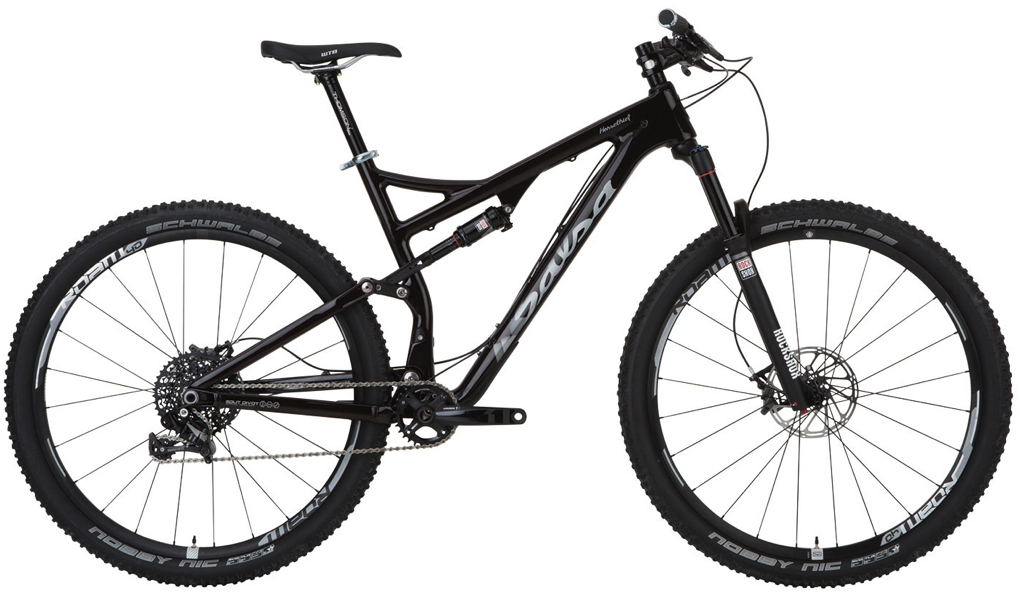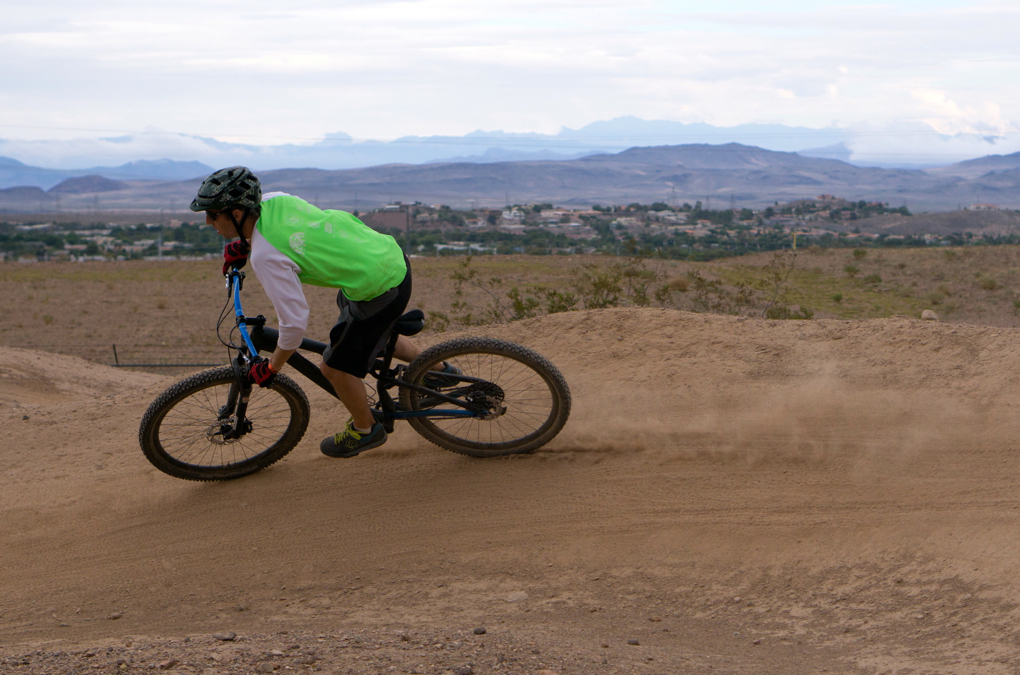Bike: 2015 Salsa Horsethief Carbon
MSRP: $4,899 (Horsethief Carbon 1; not as tested)
Size Tested: Medium
Wheels: 29″
Travel: 120mm
Reviewer Info: 5’9”, 155 lbs.
Test Location: Boulder City, Nevada

Caveat
Interbike’s outdoor demo is located at Bootleg Canyon in Boulder City, Nevada. It’s a fantastic network of trails, and it’s a great escape from that wretched hive of filth and villainy that is Las Vegas.
The trails we spent most of our time on were relatively fast, with a fair amount of sand and some pretty rocky sections.
Having said that…
Riding bikes at a demo is always kind of tricky. For starters, we’re unable to get as much time on each bike as we like–our test durations are measured in minutes and hours, not our preferred time frame of weeks and months. One good ride can tell you a lot about how a bike handles, but it certainly doesn’t allow for the customary, in-depth, Blister analysis.
Demo days also don’t generally permit the time needed to get each bike dialed to our liking. A quick suspension setup and fiddling with the bike’s ergonomics gets it most of the way there, but it takes days to really get everything running just right. Furthermore, differences like tire selection and tire pressure can have a huge effect on how a bike rides, and we generally don’t have the chance to get to tinker with those variables too much.
So while we believe it’s important to be upfront about the limitations of reviewing bikes in such settings, there is also merit in riding a slew of bikes, back to back, on the same trail. Subtle differences that might not become apparent if our test rides happen weeks or months apart are able to come to light, and each bike’s attributes may be more easily identified.
One final caveat: the particular Horsethief Carbon I rode was the personal bike of the guy who designed much of the Horsethief—Pete Koski. The frame was completely stock, but he had it outfitted with a variety of parts that aren’t offered directly from Salsa. I’ll talk a bit more about the parts spec below, but it’s something to keep in mind since the bike I rode isn’t precisely the same as what Salsa offers, though you can buy the Horsethief Carbon as a frame and build it up however you want.
Intro
Salsa has been around for quite a while, and for a long time, they were known for making nice, pretty straightforward steel hardtails. These days, Salsa is one of many brands that fall under the QBP umbrella, and they’re focused a bit more on “adventure-by-bike” type frames.
At 120mm, the Horsethief is Salsa’s longest travel bike. It, along with every other “normal” bike that Salsa makes, comes with 29” wheels. Normal is in quotes here, because Salsa does make a slew of 26” fat bikes that I have been told (over, and over, and over) are a lot of fun.
The Horsethief has been around in an aluminum version for a little while, but the carbon version that I rode is new for 2015. The frames are essentially identical, but the carbon version obviously saves a bit of weight. Both versions are built around the Split Pivot suspension platform, a Dave Weagle (of DW link) frame design that places a pivot concentric to the rear axle.
The Build
As I mentioned above, the Horsethief Carbon I rode had a custom build package on it. This included an XX1 drivetrain, some pleasantly wide bars, a Rockshox Pike set at 120mm travel, and a Cane Creek DB Inline rear shock.
While Salsa doesn’t offer the Horsethief with a XX1 kit, it does offer it with a X01 kit on the $4,899 Horsethief Carbon 1, or with a XTR kit on the aptly named Horsethief Carbon XTR. So the basic componentry on the bike I rode isn’t way off from what’s normally available for purchase from the factory.
The suspension, on the other hand, is a bit different. The stock Horsethiefs come with either a Rockshox Revelation or a Fox F29 (32mm stanchions), depending on the build kit. The Pike that was on the bike I rode, while similar in the amount of travel, is a burlier, stiffer fork that (in my experience) also has superior damping characteristics.
A similar thing can be said for the rear shock. The Cane Creek DB Inline is a super tunable rear shock that, once dialed in, offers pretty damn good suspension performance. The stock Horsethiefs come with either a Rockshox Monarch RT3 or a Fox Float CTD rear shock, neither of which are bad options by any means, but they don’t offer the breadth of adjustments found on the DB Inline.
I will say, however, that shocks like the CCDB aren’t great for a short test like the one I got on the Horsethief. It usually takes me a few days to get a Cane Creek shock dialed to my liking, so spending an hour or two on a bike isn’t really sufficient to get the shock dialed. From my quick ride, there are some areas where I thought the Horsethief could be improved, and I would speculate that a lot of those concerns could be addressed with a bit more time playing with the shock.
One of the few complaints I have about the Horsethief is that Salsa doesn’t offer it with a more aggressive build kit. The build I rode was fantastic, but the stock offerings come with flexier forks, smaller brake rotors, and a few other parts that betray the bike’s capabilities (more on that below).
The Fit
The Horsethief embraces the modern trends in bike geometry: long front end, short rear end, and a relatively slack head angle (paired to a 51mm offset fork).
The reach on the Medium Horsethief Carbon I rode was 428mm (16.85”), and it had a lengthy 610mm (24”) effective top tube. That long front end is paired to 437mm (17.2”) chainstays, which are fairly short by full suspension 29er standards.
The head angle on the Horsethief is listed as 68.1°, but from talking to Pete, the frame’s designer, it sounds like production models might have come out a hair slacker than that. The bike also comes paired with a 51mm offset fork, which seems to eliminate some of the sluggish handling that is often associated with 29ers.
The Ride
Of all the bikes I rode at Interbike, without a doubt, I felt fastest on the Horsethief Carbon. It carried speed remarkably well, and it really rewarded pumping through the trail. Following other riders, I could easily keep pace with them just by pumping along and using the terrain, even while they were putting a fair amount of effort into pedaling.

Now, to be fair, there are a couple of things that affect this. First, the loop that I spent the most time riding at Bootleg Canyon definitely favored 29ers over smaller wheel sizes. The 29ers carried better speed through some of the soft sand, and they rolled more efficiently over the chunky, square-edged rocks (of which there were plenty). And most of the “XC” trails tend more toward mellow terrain that you can hold speed on, rather than tight, twisty trails where a smaller wheel size might be advantageous. Added to that, the Horesthief Carbon 1 was built in a way that was fairly close to how I would build my personal bike, which always makes it a bit easier to go fast.
But qualifications aside, the Horesthief Carbon was just a really easy bike to go fast on, and it punches above its weight class when the going gets rough. Most other ~120mm travel bikes I’ve ridden fare OK through rougher, more technical trails, but it’s rare to find one that feels like it really wants to get into rowdier terrain. Rather, most of the trail bikes feel like they’re built around mellow, cruisy trails, and the better options will begrudgingly handle higher speeds and tech if they have to.
The Horsethief, on the other hand, felt like it wanted to pin into the rough, and go as fast as possible at all times. To be clear, the Horsethief isn’t a 160mm travel bike, and it doesn’t feel like one—you can get yourself into trouble if you push it too hard. But the Horsethief feels far more capable than your average 120mm bike; it bridges that gap between a shorter travel 29er to a longer travel all mountain / enduro bike more completely than most other comparable bikes I’ve been on.
